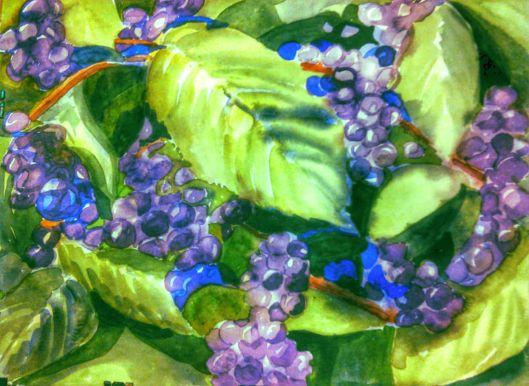Tags
140lb Arches coldpress, American Beautyberry, Callicarpa americana, color, drawing, E. B. White, expressionism, expressionist, expressive, Georgia, Location, M. Graham Watercolors, Media and Subjects, Native Plants, nature, Painting, walk in the N. Georgia woods, watercolor
34 native and nature …01 American Beautyberry
(Callicarpa americana L)
One of my favorite native plants is the American Beautyberry and since I wanted to start working p plant portraits again for a bit I thought It would be a fun choice. I believe it should have greater use as mass plantings in the landscape.
I began this painting on soaked 140lb Arches coldpressed paper establishing the basic shapes and some color contrast with Gamboge and Dioxazine Purple with a touch of Ultramarine Blue. Once this dried I began to define some of the shapes and adding more color. I wanted the painting to have a circular movement to echo the shape of the berries that are the glory of this plant in fall and winter.
This is the first painting using my new M. Graham paints on 140lb Arches coldpress. It’s a combination I plan on using quite a bit in the future. You can also see the notebook clips I like to use when painting to control warping. I like to use these clips because you can move them as you need to paint right up to the edge.
“I would feel more optimistic about a bright future for man if he spent less time proving that he can outwit Nature and more time tasting her sweetness and respecting her seniority.”
― E.B. White, Letters of E. B. White
USDA Natural Resource Conservation Service
The United States Department of Agriculture is a great resource for information about native plants.
USDA Plant Fact Sheet
American beautyberry is a fast growing native perennial shrub; growing five to eight feet tall and almost as wide with drooping branches. The elliptical to ovate shaped leaves have an opposite arrangement with saw toothed margins. The underside of the leaves may be covered with wooly like hairs. The stems are slender, gray to reddish brown, and terete or four sided. In late spring to early summer, inconspicuous flowers of blue, violet, pink, or white are arranged in clusters on the stems between the leaves. In August or September, clusters of small purple to blue berries or drupes encircle the woody stems. Each small berry in the cluster contains two to four seeds about 1/16 in. long.
This plant is distributed throughout the southeastern United States from Texas and Oklahoma east to Maryland. It also grows in the Caribbean and northern Mexico. American beautyberry is found in woods, particularly on moist areas under open pine canopies, thickets, right of ways, and fence rows. It is adapted to moist, loam, sandy or shallow upland sites and a wide pH range. The shrub is considered a pioneer species and is characteristic of the mid stages of plant succession. This plant is very tolerant of fire. However, it is intolerant of deep shade and declines in number when mid-story vegetation is dense.





Reblogged this on Line and Wash, a sketchbook and commented:
Working on ative plant portraits
LikeLike
it’s lovely !
LikeLike